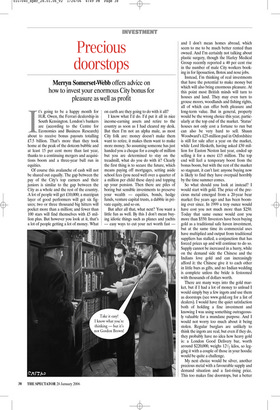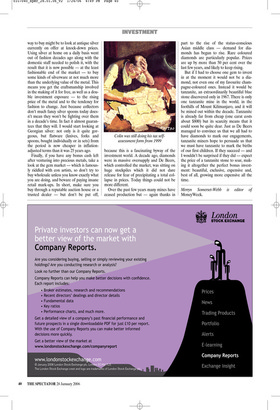Precious doorstops
Merryn Somerset-Webb offers advice on how to invest your enormous City bonus for pleasure as well as profit It’s going to be a happy month for H.R. Owen, the Ferrari dealership in South Kensington. London’s bankers are (according to the Centre for Economics and Business Research) about to receive bonus payouts totalling £7.5 billion. That’s more than they took home at the peak of the dotcom bubble and at least 15 per cent more than last year, thanks to a continuing mergers and acquisitions boom and a three-year bull run in equities.
Of course this avalanche of cash will not be shared out equally. The gap between the pay of the City’s top earners and their juniors is similar to the gap between the City as a whole and the rest of the country. A lot of people will get £10,000; a marzipan layer of good performers will get six figures; two or three thousand big hitters will pocket more than a million; and fewer than 100 stars will find themselves with £5 million plus. But however you look at it, that’s a lot of people getting a lot of money. What on earth are they going to do with it all?
I know what I’d do. I’d put it all in nice income-earning assets and retire to the country as soon as I had cleared my desk. But then I’m not an alpha male, as most City folk are: money doesn’t make them want to retire, it makes them want to make more money. So assuming someone has just handed you a cheque for a couple of million but you are determined to stay on the treadmill, what do you do with it? Clearly the first thing is to secure the future, which means paying off mortgages, setting aside school fees (you need well over a quarter of a million per child these days) and topping up your pension. Then there are piles of boring but sensible investments to preserve your wealth — equities, bonds, hedge funds, venture capital trusts, a dabble in private equity, and so on.
But after all that, what next? You want a little fun as well. By this I don’t mean buying idiotic things such as planes and yachts — easy ways to cut your net worth fast — and I don’t mean homes abroad, which seem to me to be much better rented than owned. And I’m certainly not talking about plastic surgery, though the Harley Medical Group recently reported a 40 per cent rise in the number of male City workers booking in for liposuction, Botox and nose jobs.
Instead, I’m thinking of real investments that have the potential to make money but which will also bring enormous pleasure. At this point most British minds will turn to houses and land. They may even turn to grouse moors, woodlands and fishing rights, all of which can offer both pleasure and long-term value. But in general, property would be the wrong choice this year, particularly at the top end of the market. ‘Status’ houses not only cost a fortune to run but can also be very hard to sell. Shaun Woodward’s £25-million pad in Oxfordshire is still for sale after a year on the market, while Lord Hesketh, having asked £50 million for Easton Neston last year, ended up selling it for a mere £15 million. The top end will feel a temporary boost from the bonus boom, but with the rest of the market so stagnant, it can’t last: anyone buying now is likely to find they have overpaid horribly by the time summer comes.
So what should you look at instead? I would start with gold. The price of the precious metal emerged from a 20-year bear market five years ago and has been booming ever since. In 1999 a troy ounce would have cost you not much more than $250. Today that same ounce would cost you more than $550. Investors have been buying gold as a traditional safe haven investment, but at the same time its commercial uses have multiplied and output from traditional suppliers has stalled, a conjunction that has forced prices up and will continue to do so. Supply cannot be increased in a hurry, while on the demand side the Chinese and the Indians love gold and can increasingly afford it: the Chinese give it to each other in little bars as gifts, and no Indian wedding is complete unless the bride is festooned with thousands of dollars worth.
There are many ways into the gold market, but if I had a lot of money to unload I would simply buy a few ingots and use them as doorstops (see www.gold.org for a list of dealers). I would have the quiet satisfaction both of holding a fine investment and knowing I was using something outrageously valuable for a mundane purpose. And I would not worry too much about it being stolen. Regular burglars are unlikely to think the ingots are real, but even if they do, they probably have no idea how heavy gold is: a London Good Delivery bar, worth around $220,000, weighs 121/2 kilos, so legging it with a couple of those in your hoodie would be quite a challenge.
My next choice would be silver, another precious metal with a favourable supply and demand situation and a fast-rising price. This too makes fine doorstops, but a better way to buy might be to look at antique silver currently on offer at knock-down prices. Using silver at home on a daily basis went out of fashion decades ago along with the domestic staff needed to polish it, with the result that it is now possible — at the least fashionable end of the market — to buy some kinds of silverware at not much more than the underlying value of the metal. This means you get the craftsmanship involved in the making of it for free, as well as a double investment exposure — to the rising price of the metal and to the tendency for fashion to change. Just because collectors don’t much fancy silver spoons today doesn’t mean they won’t be fighting over them in a decade’s time. In fact it almost guarantees that they will. I would start looking at Georgian silver: not only is it quite gorgeous, but flatware (knives, forks and spoons, bought individually or in sets) from the period is now cheaper in inflationadjusted terms than it was 25 years ago.
Finally, if you have any bonus cash left after venturing into precious metals, take a look at the gem market — which is famously riddled with con artists, so don’t try to buy wholesale unless you know exactly what you are doing, and beware of paying insane retail mark-ups. In short, make sure you buy through a reputable auction house or a trusted dealer — but don’t be put off, because this is a fascinating byway of the investment world. A decade ago, diamonds were in massive oversupply and De Beers, which controlled the market, was sitting on huge stockpiles which it did not dare release for fear of precipitating a total collapse in prices. Today things could not be more different.
Over the past few years many mines have ceased production but — again thanks in part to the rise of the status-conscious Asian middle class — demand for diamonds has begun to rise. Rare coloured diamonds are particularly popular. Prices are up by more than 50 per cent over the last few years, and likely to keep rising.
But if I had to choose one gem to invest in at the moment it would not be a diamond, not even one of my favourite champagne-coloured ones. Instead it would be tanzanite, an extraordinarily beautiful blue stone discovered only in 1967. There is only one tanzanite mine in the world, in the foothills of Mount Kilimanjaro, and it will be mined out within the decade. Tanzanite is already far from cheap (one carat costs about $800) but its scarcity means that it could soon be quite dear. Just as De Beers managed to convince us that we all had to have diamonds to mark our engagements, tanzanite miners hope to persuade us that we must have tanzanite to mark the births of our first children. If they succeed — and I wouldn’t be surprised if they did — expect the price of a tanzanite stone to soar, making it altogether the perfect bonus investment: beautiful, exclusive, expensive and, best of all, growing more expensive all the time.
Merryn Somerset-Webb is editor of MoneyWeek.























































 Previous page
Previous page